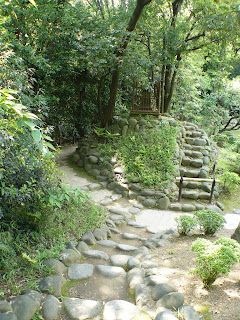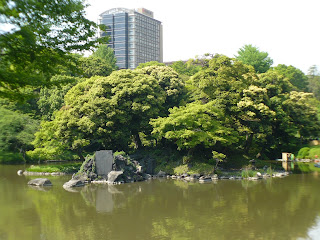Nestled in the corner of the super-block that contains the Tokyo Dome, an amusement park, and other attractions sits Koishikawa Korakuen, a sight I consider a must-see for tourists interested in traditional Japanese gardens.
Be warned that while the text is minimal for each photo, there are dozens of pictures here!
The park is accessed from a corner entrance off the main street. It can be difficult to find if you don't know where you're going.A maze of paths lead through the park around the lake, surrounded by carefully manicured lawns and trees.
The paths basically form two circles around the lake, with some connecting paths.
The lake forms several peninsulas and bays and the large number of trees make you feel like you're frequently in some new, different garden.
When I visited, the weather was perfect.
There are a few places to sit and enjoy a snack, but the park has other draws.
Follow the stone steps up the hill...
Go around the bend...
And there's a shrine!
And an arched bridge!
Beautiful views through the trees!
And more stone steps!
This is another view of the same bridge.
Beneath the bridge, a small portion of the lake feels like its own pond.
The park is designed to replicate some of the most beautiful natural views in Asia.
Despite the large size of the park, the landscaping really isolates each highlight, letting it stand out even more.
One last look at the bridge.
Heading back along the outer path, a view of the rest of the park opens up.
Another nice view.
This is a replica of Byobu-iwa. The rock was called Byobu-iwa, or a picture screen rock, because it rose vertically like a picture screen. It is said that the third shogun, Iemitsu often visited this place and sat on the stone by the river.
Seiko-no-tsutsumi. These stone steps were made to imitate a famous sightseeing spot in China, West Lake. Many gardens of feudal lords followed this style. This is a miniature dike of the original at Lake Xi Hu (West Lake) of Chechiang Province, in China.
Fish in the water!
A waterfall in the background.
Through the fern.
There are some ducks in the pond.
If you're quiet and calm enough, they might come near you as they go about their business.
Tree hanging over the water. Always attractive.
Follow the path!
Rice and lily fields are tucked in different corners of the park.
A traditional stone arch bridge.
I've seen a few of these as I've traveled around Japan. So far, I don't think they've been open for actually walking on.
Another view from the top of the hill.
These steps (looking down) are another replica, this time of Atago-zaka.
This slope with stone steps is an imitation of the one in Mt. Atago in Kyoto. There are 47 steps in all.
When Mitsukumi, the 2nd lord of Mito-Tokugawa family, met the 3rd shogun, Iemitsu, he was given a statue of a patron saint of literature. Later he built a small shrine called Hakk-do to enshrine the statue in. The shrine was burnt down in the big fire after the 1923 earthquake.
A small grove is tucked into another corner of the park.
When I visited, the plums were growing.
Some of the trees in this portion of the park have amazing shapes.
Picture opportunities are found everywhere you look.
I was so tempted to put something in those giant mouths.
Here are the rice fields.
A traditional house next to the rice fields.
The lake has an island with a small shrine. You can't get on the island.
A closer look at the island.
Eiyo-hi. When the beloved falcon which the 7th lord of Mito-Tokugawa family was given by the shogun died, the 8th lord erected this monument.
Walk up the steps!
In the back of the park, tucked into yet another corner, there is a smaller lake with its own island and bridge.
Another tree hangs precariously over the water next to the lily pads.
The lake is home to several turtles and more fish.
The back entrance to the park is found here, though it's never open.
The bridge and island look really nice, though you can't go out there either.
Around the lake is a series of small attractions.
Here is another carved stone.
Go up the steps!
Almost there...
A small shrine or place to sit.
What we need is more shrubbery...
If you've been paying close enough attention, you've noticed that buildings can be seen from the more open areas. In one corner of the park, you can see the Tokyo Dome pretty well.
Finally around to the other side of the park, I found a nice wooden path.
The best views are found if you follow the outside path, coming back to the inside path occasionally.
Coming back to the inside gives occasional nice views of the island.
But heading back to the inside gives peaceful views of a small stream.
This are used to house a small shrine. I took a few minutes to try some random up-close photos.
Close-up on the lion?
One of these shrine lantern stone things. I don't know what they're called.
Budding branch.
Kare-Taki (waterfall having no water). It's found near the front gate, on the right side of the park.
I'm finally back at the front gate. The park is large and has so many great areas to enjoy and study. If you really want to see it all, plan on taking up to two hours to meander along the paths. But with even an hour to spare, you can take a stroll around the shorter inside path or explore one side of the park.
Koishikawa Korakuen is one of the three most beautiful parks in Japan. It's a short walk from Iidabashi Station, Suidobashi Station, or Korakuen Station (though Korakuen Station is the farthest from the entrance). Use the maps just outside the stations and follow the signs to get to the entrance. Note that the sign on the main road from Iidabashi Station is somewhat hidden behind another post.
The park is open daily from 9-5, though it's closed around New Years for a few days. Admission is only 300 yen, a small price to pay for such a beautiful garden.
























































































No comments:
Post a Comment